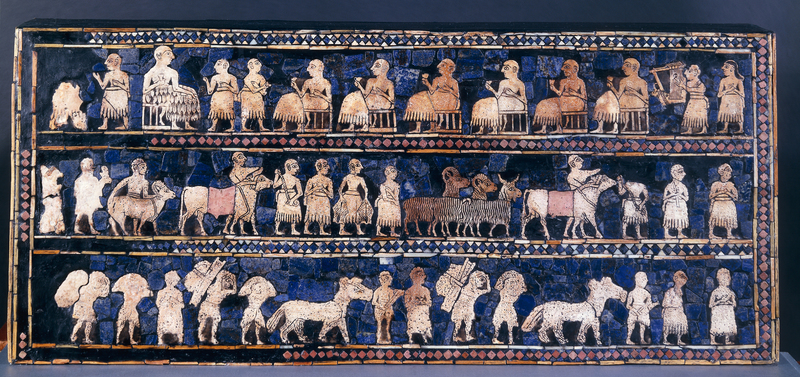Realism and Artistic Narrative
In the first chapter of her “On Art in he Ancient Near East”, Winter establishes artistic realism as a key tenet of pictorial narrative propaganda. For a particular piece of art to be effective in this kind of subliminal messaging, it would need to be a plausible representation of the physical reality of its depictions, otherwise the viewer of said piece would presumably not be convinced of its validity. Winter’s argument is also predicated on the idea that the Nimrud reliefs represent the first true instance of historical narrative art; that is, they do not obviously distort reality in a way that undermines their credibility as at least somewhat accurate renditions of actual events. Previous artistic renditions of royalty in Mesopotamia had usually exaggerated the power of the king or the grotesqueness of his punishment, for example, but the Nimrud reliefs may have been the first instance of visual art that tells a story independent of a text. The reliefs can almost be read as if they are describing sequences of action, and it is precisely this quality that makes them an effective medium of royal propaganda. The depictions are deliberately intended to be interpreted as historical, exemplifying the type of subliminal deceit employed by propaganda.
Winter begins her argument by showing how the depictions themselves begin to to be read as narratives. Specifically, she discusses how these artists created movement, which itself underscores the concept of action; that is, for a particular piece of art to be depicting action, it must contain movement, usually of animate objects. Though the bodies are shown in various positions, she notes, “all heads are rendered in profile… the profile view conveys action and involvement of the actors in a space of their own, and is hence most appropriate for the representation of the historic event in its actuality” (Winter 12). Though the profile view had been used for centuries in Mesopotamian and Egyptian Art, it had never really been placed in the kind of scenery present in many of the Nimrud reliefs. The scenery represents, “a development toward greater use of the pictorial field and spatial dimensions, the inclusion of more pervasive identifiers such as topographic details” (Winter 6). These details play a vital role in contextualizing the figures so that the piece can be understood as a particular event in a particular place i.e. something that happened – a historical event.
The use of a more detailed pictorial field, however, was not the the only element that separated it from the art of previous societies. Realism in the depiction of the figures themselves also contributed greatly to the historicity of the reliefs in comparison to earlier artistic renditions of kingship. On both sides of the Standard of Ur, for example, the king is physically larger compared to the other to the other figures in the registers. In every relief from Ashurnasirpal’s Northwest Palace, “the king is shown at the same size or only marginally larger than his fellows, and is distinguishable mainly by his royal head dress, fringed and wrapped garment, palanquin-bearer behind, and occasionally also by his pride of place in battle. As a result of this equality in scale-a major signifier in the scenes (Barthes 1977b:46; Schapiro 1969)-the historicity of the action is not diluted by conceptual distortions, and emphasis is on the action unfolding in each sequence” (Winter 12-13). This type of distortion is not consistent with the requisite level of realism for a work to be effective propaganda; this would be more likely to project power rather than subtle influence. Thus, there is a distinction between the mere instilment of fear and tactful manipulation, the Nimrud reliefs being the latter.
The aforementioned novel artistic techniques all contribute to Winter’s notion of realism. To establish a working definition of artistic realism, she calls upon Roman Jakobsen, who provides two conditions for realism: “(1) that the author be concerned with displaying verisimilitude and (2) that the audience or individual judging it perceived it as true to life.” (Winter 16). The viewer must be able to immediately establish the relationship between the image and the objects or people to which it corresponds; that is, the image transcends its status as a mere depiction to invoke a sense of reality. If the image is indeed successful in this invocation, “recognition becomes instantaneous: one no longer sees a ‘picture’”(Winter 17). This definition of artistic realism appropriately highlights the innovation in the reliefs discovered at Nimrud; it is precisely this innovation that allows for the reliefs to be modes of propaganda, for the use of realism allowed Ashurnasirpal to conflate his imperial ideology with history itself, a fete not yet achieved by the kings and artists before him.

